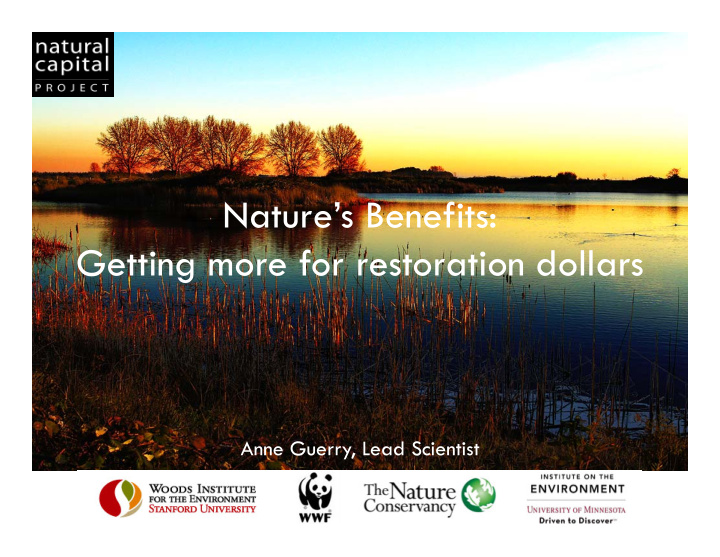



Nature’s Benefits: Getting more for restoration dollars Anne Guerry, Lead Scientist
“If we were running a business with the biosphere as our major asset, we would not allow it to depreciate. We would ensure that all necessary repairs and maintenance were carried out on a regular basis.” - Alan Malcolm
Natural Capital Financial Built Capital Capital Human Social Capital Capital
Developing science in support of decisions
1. Oceans and coasts provide many diverse benefits to people
2. Degraded systems provide fewer benefits Photo: VIMS
3. Restoration can bring back lost benefits Summary of 89 restoration assessments: • Restoration increased biodiversity by 44% • Restoration increased ecosystem services by 25% Rey Benayas 2009
4. We can value nature’s benefits
Model Outputs Marine InVEST Models (ecosystem services & values) ECOSYSTEM VALUATION e.g. SERVICES Value of Carbon carbon Carbon Sequestered sequestered Renewable Value of Energy captured Energy Captured wave energy 3 Coastal Avoided Value of 9 avoided Protection Area Habitat damages/# Flooded/Erod people affected Risk ed Expenditures Visitation 5 Recreation due to Rates 4 recreation 7 activity Water Landed 8 1 Fisheries Net present Quality Biomass value of 6 finfish and Harvested Aquaculture shellfish 2 Biomass Aesthetic Quality Guerry et al 2012
National Climate Assessment Where do habitats reduce the vulnerability of coastal communities to sea level rise? Population metrics • total population • elderly population • population below poverty line
Action: restore 10 ha of seagrass Scenario: major hurricane For every $1 spent in restoration, get $1.83 back Arkema et al in prep
5. Restoration is expensive TEEB 2009
Action: restore 10 ha of seagrass Scenario: major hurricane For every $1 spent in restoration, get $1.83 back For every $1 spent in conservation, get $833 back Arkema et al in prep
6. Economic benefits of restoration across sectors can outweigh costs Bullock et al 2011 (from Blignaut et al. 2010)
habitat value ($) of reefs > oyster harvest value ($) Peterson et al 2003
Oyster Reefs at Risk 85% loss of oyster reef ecosystems in bays and ecoregions; mangrove and saltmarsh (~50%) and coral reef (~20%) Beck et al BioScience 2011
Oyster harvest Habitat for commercially important finfish Protection of the shoreline from coastal hazards Water quality
Rebuild Reef Natural Capital long-term sustainable harvests of oysters increased resilience to storms full spectrum of benefits
The American Recovery and Reinvestment Act and NOAA helped TNC build oyster reefs and create marshes in Mobile Bay
• Used habitat suitability in design • Poised to put shells in the water • Expected shoreline protection benefits
Practical guidance for design & Expected shoreline change
Smart use of science helped get more for the restoration $ Mechanistic modeling of coastal processes avoided unintended consequences
Full Time Employees FTE at Height of the Project: 31 FTE = 83 positions Average FTE for the Project (20 months): 17 FTE = 44 positions
ARRA job creation $1M in coastal restoration 17-30 jobs Over 2x the job creation of oil, gas & transportation sectors combined
Appetite for restoration $680 million $3 billion
Restoration provides diverse • benefits Smart restoration projects • maximize diverse benefits A focus on nature’s benefits can • shift incentives & help redirect existing funds Rebuild capital. Don’t keep • spending what’s left of the principal
Gulf of Mexico Restoration Decision Support A project to inform the identification of restoration projects with maximum socio-economic and ecological benefits www.Gulfmex.CoastalResilience.org
InVEST Accounting for nature’s benefits Its free! and open source! anne.guerry@standford.edu www.naturalcapitalproject.org
Model Results
Recommend
More recommend